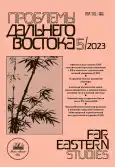The Revival of China's Tea Industry in the Years of Reform
- Autores: Aleksakhina S.N.1
-
Afiliações:
- Institute of Oriental Studies, Russian Academy of Sciences
- Edição: Nº 5 (2023)
- Páginas: 48-64
- Seção: Articles
- URL: https://journals.rcsi.science/0131-2812/article/view/251199
- DOI: https://doi.org/10.31857/S013128120028030-4
- ID: 251199
Texto integral
Resumo
Palavras-chave
Sobre autores
Svetlana Aleksakhina
Institute of Oriental Studies, Russian Academy of Sciences
ORCID ID: 0009-0006-8432-8178
/1, Rozhdestvenka str., Moscow, 107031, Russian Federation
Bibliografia
- Жань Шаньчуань. Китайский чай // Китай. 2023. № 2–3(204). С. 50–51.
- Жань Шаньчуань. Новая картина подъема села // Китай. № 12 (202). С. 12–15.
- Исаева Л.И. Радость на кончиках бровей. М.: ИДВ РАН, 2005. 798 с.
- Си Цзиньпин. Высоко неся великое знамя социализма с китайской спецификой, сплоченно бороться за всестороннее строительство модернизированного социалистического государства (Доклад на XX съезде Коммунистической партии Китая 16 октября 2022 г.) — 72 с.) // CCTN. 25.10.2022. URL: https://russian.cgtn.com/event/doc/ru SJIsd 23–2022 10 25. pdf. С. 29–30. (дата обращения: 27.05.2023).
- Смоленцева Е.В. Динамика площадей чайных плантаций и производство чая в мире // Московский экономический журнал. 2019. № 8. С. 3. URL: https://qje.su/nauki-o-zemle/moskovskij-ekonomicheskij-zhurnal-8–2019–20/ (дата обращения: 25.09.2023). doi: 10.24411/2413–046Х-2019–18020
- Современная китайская деревня: основные тенденции социально-экономического развития. М.: ИБ ИДВ РАН, 1992. № 5. Ч. 1. 124 с.
- Трактаты о чае эпох Тан и Сун / Пер. с кит. Дрейзис Ю.М. М.: Международная издательская компания «Шанс», 2021. 271 с.
- Цзю Цзипин. «Канон чая» в иллюстрациях / Пер. с кит. Сергеевой Ф.Д. М: Международная издательская компания «Шанс», 2023. 203 с.
- Чжан Сяолин. Значение учреждения Международного дня чая в контексте развития мировой чайной промышленности //Проблемы Дальнего Востока, 2021. № 5. С. 187–196.
- Чэнь Кэ. Новая точка опоры для подъема села // Китай. № 11 (201). С. 38–39.
- Шведов М. Н. Призрак Дао: современная чайная культура Китая // Вестник Томского государственного университета, 2012. № 357. C. 115–117.
- 茶业数据:2022年中国茶叶生产与内销形势分析 (Статистические данные по чайной отрасли: Анализ производства чая в Китае и его продажа на внутреннем рынке) // 普洱茶网. 11.05.2023. URL: https://www.puercn.com/news/138327/#:~:text=%E7%BB%BF%E8%8C%B6%E3%80%81%E7%BA%A2%E8%8C%B6%E3%80%81%E9%BB%91,0.37%25(%E8%A1%A85)%E3%80%82 (дата обращения: 13.07.2023).
- 中国统计年鉴 -2003 (Китайский статистический ежегодник- 2003) 北京:中国统计出版社, 2003.
- 中国统计年鉴 -2007 (Китайский статистический ежегодник -2007) 北京:中国统计出版社, 2007.









